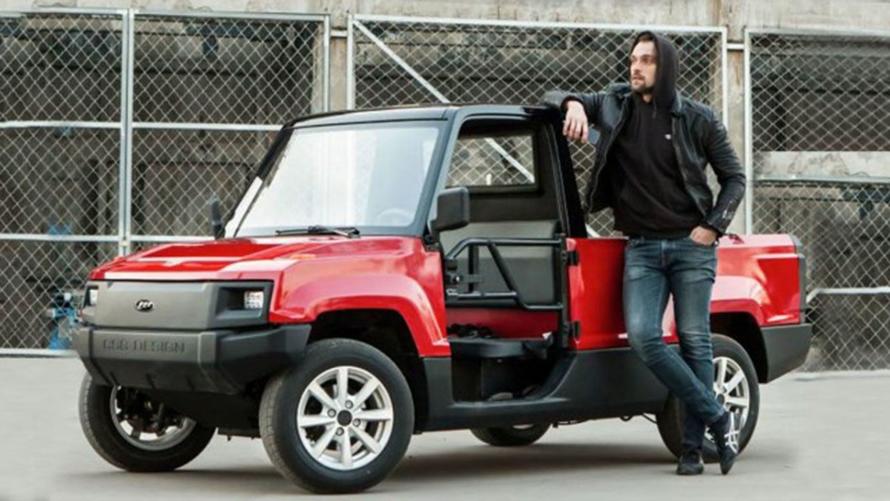
Wang Chao is an optimist. The founder of Kaiyun Motors hopes to transition owners of Ford F-150 pickups over to a Kaiyun Pickman. The Pickman is now NHTSA-approved for sale in USA and equivalently approved in Europe, where it is being sold in Germany and Italy.
While reports on the vehicle in January 2019, stated that it would cost $5 000 in USA and €5 000 in Europe, the American price had escalated to $9 000 by the middle of February, for a street-legal version; about $6 000 for a farm version.
While there must be caveats about the lack of safety features, the Pickman is undoubtedly an appropriate farm vehicle in rural environments, and a suitable vehicle for urban tradespeople. It is inappropriate for a daily commute involving any form of highway driving.
The Pickman is an example of a Low Speed Electric Vehicle, ususally referred to as a Neighborhood Electric Vehicle (USA) or Quadricycle (Europe). These are defined by limitations in terms of mass (weight), power and speed. All quadricycles must have a top speed of 45 km/h or less. In USA the limit is usually 25 mph or 40 km/h. In Europe, there are two categories: light quadricycles (L6e) and heavy quadricycles (L7e). A L6e EV must have a curb weight of 425 kg or less, and an electric motor producing 4 kW or less. A L7e EV must have a curb weight of 450 kg or less (passenger vehicles) or 600 kg or less (goods vehicles), The load capacity must be 200 kg or less (passenger vehicle) or 1000 kg or less (goods vehicle), with a maximum net engine power of 15 kW or less. .
The Pickman is powered by a 4 kW permanent magnet based electric motor with an asynchronization intelligent controller, mated to a 72V lead-acid battery pack providing 100 Ah or 7.2 kWh (26 MJ) of energy. Top speed is 45 km/h and range is 120 kilometers. There is some discussion about the load capacity. Some figures, in the table below are taken from a Chinese version, which appears to have a load capacity of 300 kg. The accuracy of the figures below is not guaranteed!
| Specifications for base 2019 models | Pickman | F-150 |
| Length/ mm | 3 245 | 5 316 |
| Width/ mm (excluding mirrors) | 1 320 | 2 029 |
| Height/ mm | 1 460 | 1 918 |
| Wheel Base/ mm | 2 078 | 3 109 |
| Ground clearance/ mm | 150 | 224 |
| Load capacity (including driver/ passengers)/ kg | 500 | 846 |
| Curb weight/ kg | 680 | 2 008 |
Note: Curb weight is the total weight of a vehicle with standard equipment, all necessary operating consumables such as motor oil, transmission oil, coolant, air conditioning refrigerant, and a full tank of fuel, while not loaded with either passengers or cargo. Note: In Europe, the mass of the batteries is excluded when determining vehicle curb weight.


My first time seeing these. Ideal vehicles for somewhere such as Gozo, Malta, or even grocery store runs in the US suburbs. I wonder if these qualify for an electric vehicle tax credit in the US.
Soon, I will be reviewing a couple more NEVs/quadracycles, that may be appropriate to use in a low speed urban commute. I thought that it would be appropriate to discuss some of the operating costs of such a vehicle. As most people know, while the servicing costs of an EV approach zero, what most people fear is degradation of their batteries, which can be quite costly, especially if lithium in involved. Lead-acid? Not so much. In Norway, insurance is also considerably lower priced, and there are also a number of other perks available that make owning an EV worthwhile.
Fuel costs are also lower. I looked up the fuel consumption of a modest Ford F-150 diesel, and got 7.8 litres per 100 km. To make this the same, as the charge equivalent of the Pickman range on a single charge, which is 120 km, let me multiply this by 1.2 x 7.8 = 9.36 litres. Today’s low price for diesel was NOK 14 per litre gives a range price of 14 x 9.36 = NOK 131. The price of 1 kWh of electricity at Vangshylla is NOK 0.65 for power, plus NOK 0.51 for line delivery, making a total of NOK 1.16. One charge takes 7.2 kWh, but let us be generous and say there is a 10% energy loss, so that the Pickman needs 8 kWh for 120 km. The price of this would be 1.16 x 8 = NOK 9.28. Energy costs of a Pickman are (9.28/131) x 100 = 7% of the energy costs of a F-150.
See: https://agario7.com/2019-ford-f-150-diesel/2019-ford-f-150-diesel-fuel-economy-mpg/
I just bought one. It will take 60 days for delivery. I am going to use that time to upgrade my PV solar system on my roof to provide power to charge it. 10,000.00 is not a lot for a second vehicle that is perfect for errands and to abandon when you want to go out for a drink.